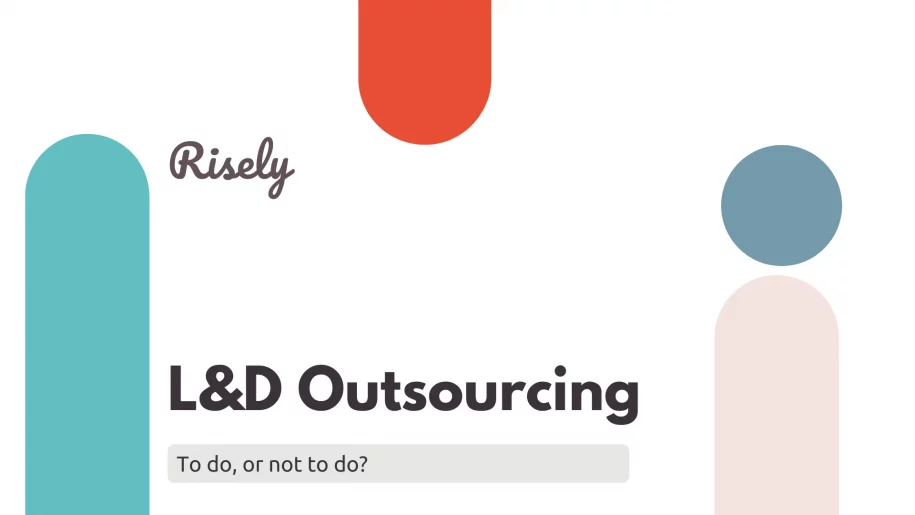To Do or Not To Do: Learning and Development Outsourcing
Learning and development teams have a lot to do. However, your bandwidth is often limited. As teams rapidly expand, evolving training needs arise due to technological advancements, and people want to see an impact before they move the budgets ahead; it’s a lot for an L&D team to handle. Given the wide range of learning and development needs, L&D strategies need to make space for external providers. Is it the right choice for your team? To answer that, let’s try to understand learning and development outsourcing in detail below.What is learning and development outsourcing?
Learning and development outsourcing means hiring an outside company to manage employee training. Instead of just using your own staff, you can use the skills and resources of special L&D providers. This teamwork lets you access more knowledge, the latest technologies, and new training ideas that you may not have on your own. By outsourcing some L&D jobs or even complete training programs, you improve training efforts and reach your strategic goals more efficiently without overwhelming the function. It becomes important when we note that about 87% companies surveyed by McKinsey were either experiencing a capability gap or expecting it pretty soon.- Fully outsourced L&D ops: As the name suggests, the entire training and development program is managed by an external provider. This service is most commonly used by companies that lack the internal resources and bandwidth to conduct required training. It includes collaboration with your leadership to develop effective strategies and then complete the execution of the action plans with analytics, reporting, and feedback.
- Project-based outsourcing for L&D: As the name suggests, this includes hiring relevant specialists, consultants, and/or vendors to meet your company’s learning and development needs in a specific area. The applications of outsourcing work like this commonly include instructional design agencies, content development houses, video production companies, eLearning development specialists, and assessment design experts.
- Individual contractors: You can also use L&D outsourcing to complement your organization’s internal learning development initiatives. For instance, you can hire an instructional designer to turn the know-how of subject matter experts into easily understandable learning content. Similarly, individual contractors and freelancers are available for many functional areas of L&D, such as technical writing, LMS administration, and learning experience design.
- Content Development: Creating training materials that are helpful and engaging takes a lot of time. It also needs special skills in designing instruction. By outsourcing content development to experts, you get high-quality, tailored training materials for their specific training needs.
- Compliance Training: It is tough to keep up with changing rules and compliance standards. This task takes a lot of time and resources. Outsourcing compliance training makes sure your workforce receives the correct and current training in a fun and effective way.
- Technology Implementation and Support: Setting up and managing systems for learning, like Learning Management Systems (LMS), needs technical skills. When you outsource these tasks to experts, you enjoy smooth integration and ongoing help. This also allows your IT team to focus on other important business systems.
Why should you consider outsourcing L&D?
One big reason why more companies are choosing to outsource L&D is the many benefits it provides. In the survey cited above, McKinsey also notes that half the people noticing skill gaps put “reskilling” as the most important combat move for their teams. But, that means an intense run for already burdened L&D teams! Thus, when you hire experts for certain training tasks, your internal teams are free to focus more on important business tasks. It keeps your operations smoother and improves overall work efficiency. Plus, reskilling ensures cost savings as compared to hiring. Outsourcing also allows you to work with top L&D professionals and new technologies without the hassle of hiring people, investing in infrastructure, or dealing with training costs for your internal staff. Whether it’s leadership development, technical skills training, or compliance programs, you can find specialized help to create effective learning experiences. It’s a great way to develop talent in new areas which are not already present in your team. This, in turn, boosts employee satisfaction and helps you curb turnover.Things to consider before L&D outsourcing
But, there are costs to manage when your are thinking of learning and development outsourcing. First up, you have to pay the vendors and contractors you will engage. You will also need to ensure that they have an open communication channel with your team, potentially bringing up costs for managing the vendor relationship, communication, and tracking performance. Think on both the fronts: the benefits you get and the costs you pay before deciding. Primarily, consider these questions when you are thinking of outsourcing L&D ops:- What is the cost structure, and how are fixed versus variable costs managed?
- What quality control processes are in place to ensure consistency?
- Who holds IP ownership, and what are the terms around it?
- How will this integrate with our internal teams and existing workflows?
- Can this solution scale to meet growing demands or needs?
- Are there any specific geographic or cultural requirements we should consider?
Other Interesting Reads
When should you outsource L&D?
Before outsourcing, you should carefully look at your Learning and Development functions. You need to clearly tell apart which activities are core and which are non-core.- Core L&D functions are those that are closely linked to the main business processes. These tasks strongly impact the your company’s goals. Usually, it’s best to keep these core functions in-house. This helps maintain the company’s culture, values, and long-term vision.
- Non-core L&D functions, on the other hand, often require special skills or knowledge that may not be available within the company. These could include tasks like content development, platform administration, or parts of compliance training.
#1 You have to scale L&D ops rapidly
Sudden demands are not new. They happen often when a company rapidly expands operations or the competitive environment changes quickly. As a result, you need to roll out training yesterday and implement it today already. When growth outpaces the internal L&D capacity, you need support. Outsourced L&D operations are a great saver in such situations because you can reach more areas quickly with them. It’s a good way to get through a major product launch that requires everyone to brush up on their knowledge or a new offshore team that uses a different language than yours.#2 Your team needs specialized training
Another scenario where learning and development outsourcing can help you is when the needed expertise is not core to your business. In such cases, you would hardly have enough internal experts to create and guide training programs for highly technical or regulated areas. These L&D programs are often shaped like one-off programs outside the core business focus, have certifications requiring accredited providers, or involve complex simulations or specialized learning technology. For most L&D teams, building such capacity is a big ask; thus, outsourcing is the way to go.#3 You need to mitigate infrastructure cost
Not all training can happen quietly in rooms with just a whiteboard. When training involves high infrastructure costs that outweigh outsourcing, you should go this route. For instance, your company ideally needs leadership coaches for people managers. But you do not have enough senior leaders who can double up as coaches. Executive coaching is expensive. What’s the way out? An AI coach like Merlin for people managers fills in. Similarly, high infrastructure cost could mean investing in high-end video production needs or VR/AR content development. Large-scale content localization projects are another area you can outsource instead of building in-house capacity.When should you not outsource L&D?
On the flip side, some scenarios exist where learning and development outsourcing does not make sense, such as:#1 Your core business knowledge is involved
When learning directly relates to competitive advantage, you must keep it in-house. Why? At this stage, you are likely delving into proprietary processes and methodologies. These could include company-specific employee development practices and strategic capability-building programs that are closely tied to your team’s context and challenges. As noted above, core L&D areas directly impact business outcomes and maintain the company’s culture, values, and long-term vision. Hence, they need to remain under your purview.#2 Your sensitive information/IP is involved
Like culture and core values, your company’s sensitive information, such as IPs and internal processes, must remain confidential. In such instances, you must not outsource learning and development initiatives. It includes programs involving unannounced or unreleased products, strategy-related training, competitive intelligence, and market positioning.#3 Your L&D plan needs continuous evaluation and updates
Training needs are often dynamic. Contacting vendors to update learning programs as your business priorities shift would create a significant burden. It is commonly observed with agile learning initiatives tied to product development and programs closely tied to employee feedback. A high degree of integration with internal processes and workflows can impede synergy with external L&D service providers. In such cases, you should stick with in-house learning and development plans.To sum up
Making smart choices about which parts of L&D to outsource is important. It helps you use outside skills while keeping control over key learning projects. First, look at which L&D tasks take a lot of resources, need special skills, or can be done better by outside teams. You should think about some things like how complex the training materials are, whether you have the skills in-house, how urgent the training is, and the possible cost savings from outsourcing. Successfully handling the challenges of L&D outsourcing needs a well-organized plan based on industry standards. It’s not just about handing off tasks. It’s about building partnerships that match your organization’s values, goals, and focus on promoting a culture of ongoing learning.Build your L&D plan with a free template!
Grab free resources to boost L&D and leadership development functions with Risely.
AI and Leadership Development: Driving Synergy for Growth
AI and Leadership Development: Driving Synergy for Growth You know the frustration all too well. Your organization invests thousands in…
How Are AI Learning Platforms Transforming Leadership Development?
How Are AI Learning Platforms Transforming Leadership Development? As an L&D leader, you’re likely familiar with this frustrating reality: 82%…
5 Essential AI Skills for L&D Leaders
5 Essential AI Skills for L&D Leaders According to LinkedIn’s 2025 Workplace Learning Report(1), 71% of L&D professionals are now…
How to Create a Course with AI: A Guide for L&D Professionals
How to Create a Course with AI: A Guide for L&D Professionals According to a McKinsey survey(1), only 11% of…
Building an Ultimate Leadership Development Action Plan
How to Build a Leadership Development Action Plan? Having a strong Leadership Development Action Plan is more critical than ever…


